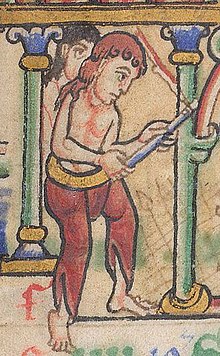

Braies are a type of trouser worn by Celtic and Germanic tribes in antiquity and by Europeans subsequently into the Middle Ages. In the later Middle Ages they were used exclusively as undergarments. Braies generally hung to the knees or mid-calf, resembling what are today called shorts. They were made of leather, wool, or, in later years, cotton or linen. They were adopted by the Romans as braccae.[1] By the 11th century, Braies were ankle-length pants held in place by a cord fitted through the top.[2][3] People from upper classes wore more fitting braies while people of the lower classes typically wore loose braies.[4]
- ^ Miriam Webster dictionary
- ^ Laver, James (2020-04-14). Costume and Fashion: A Concise History (World of Art). Thames & Hudson. ISBN 978-0-500-77514-1.
- ^ Van Brunt, Nancye (1990-05-04). "A Concise History of Underwear from Ancient Times to 1918". Morehead State Theses and Dissertations: 22–23.
- ^ Bradfield, N. (2017-09-15). Historical Costumes of England - From the Eleventh to the Twentieth Century. Read Books Ltd. ISBN 978-1-4733-4137-1.